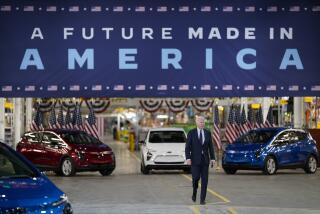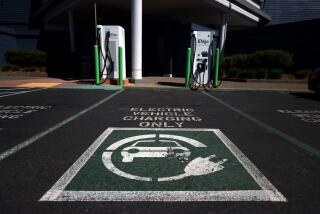A long road to mileage goals
Cars are set to get dramatically better mileage in the next decade under the energy bill that’s expected to get final congressional approval today. But for drivers hoping to see sport utility vehicles go the way of the dinosaurs and find dealerships stocked with hybrids and high-tech fuel-cell vehicles, the future may be a long way off.
The legislation requires that new mileage standards take effect in the 2011 model year with modest increases, ramping up to 35 miles per gallon in 2020.
That’s about one-third better fuel economy than current levels, but thanks to legislative wrangling by the automakers, the new rules offer them opportunities to comply by simply tweaking the same kinds of cars and trucks they produce today, rather than make sweeping changes.
Expect subtle improvements such as direct fuel injection, lightweight aluminum body panels and electric assisted power steering. And thanks to credits for ethanol use provided by the bill, companies are planning to increase their production of inefficient trucks that consume the corn-based fuel, even though ethanol isn’t sold in many states, including California.
“This is an important first step, but it’s not a panacea,” said Jim Kliesch, senior analyst at the Union of Concerned Scientists. “In fact, the technology is here today to exceed 35 mpg.”
Paul Portney, who as chairman of a vehicle fuel-efficiency committee at the National Academy of Sciences wrote a landmark study of fuel economy regulation, said the legislation “may allow carmakers plenty of chances to game the system.” His panel concluded that carmakers could reach a fleetwide average of 37 mpg by 2017.
Under the new regulation, the fuel-economy average for all makers selling cars in the U.S. would be 35 mpg, rather than the company-by-company approach currently applied. According to the Transportation Department, the 2007 combined rating for all automakers is 26.4 mpg.
As a result, some manufacturers, particularly those selling smaller cars, will probably be asked to meet a higher standard, while the bar may be lower for those with fleets heavy on trucks and large passenger cars.
A recent study by the University of Michigan’s Transportation Research Institute indicated that Honda Motor Co. vehicles would have to get an average of 39.2 mpg by 2020, while the Big Three U.S. automakers may only need to reach 33.2 mpg.
Moreover, the study concluded, the higher standards will actually be more profitable for companies like General Motors Corp., Ford Motor Co. and Chrysler, as well as Toyota Motor Corp., because they can improve mileage on their lowest-mileage vehicles relatively cheaply. Such models happen to have the highest profit margins. Those four companies, according to the study, would reap $14.4 billion of the predicted $18.9 billion in additional profit from higher prices of fuel-efficient vehicles by 2020.
Automakers, however, say the new standards could be cripplingly expensive. Some executives have predicted that compliance would add as much as $7,000 to the retail price of a vehicle, and the National Highway Traffic Safety Administration said the total cost of implementing the standards could be $114 billion.
“It’s going to be a very expensive process,” said Mike Stanton, president and chief executive of the Assn. of International Automobile Manufacturers.
Yet industry analysts say that many of the changes carmakers will be making, at least in the short term, use relatively inexpensive technology, such as subtle improvements on the gasoline engine and increased use of five- and six-speed automatic transmissions. Such modifications, they note, don’t require retooling of factories or expensive redesigns.
Ford recently announced plans to use direct fuel injection and turbochargers on much of its existing fleet. Carmakers “will do the least expensive and most cost-effective things first,” said the Union of Concerned Scientists’ Kliesch, citing data suggesting that the cost increase would be less than $1,600 per vehicle. New technologies, like alternative power trains or light carbon fiber frame construction, could be put off for years.
Another factor is ethanol. The energy bill promotes so-called flex-fuel vehicles, which are designed to run on pure gasoline or gasoline blends with as much as 85% ethanol, called E85.
Through 2014, credits for producing flex-fuel vehicles -- typically trucks and SUVs -- can be used to increase a company’s overall fleet mileage mark by 1.2 mpg. Though that number tapers to zero by 2020, it’s no wonder that GM, Chrysler and even Nissan Motor Co. are working hard to produce more flex-fuel vehicles. Ford expects to double its output to roughly 500,000 by 2010.
Critics point out that because ethanol produces less energy, gallon for gallon, than gasoline, the efficiency of flex-fuel vehicles running on E85 is dramatically lower. Yet because of the credit system, the vehicles often enjoy an effective mileage rating 50% higher than their actual rating.
The new legislation will allow carmakers to swap excess mileage credits across their passenger vehicle and truck segments, allowing the strength of one area to offset weakness in another.
Greg Martin, a GM spokesman in Washington, predicts that many carmakers will focus on the two extremes of the spectrum, “loading up microcars on one end and big trucks and SUVs on the other.”
The theory is that ultra-efficient commuter vehicles will be sold in high volume at lower prices to balance out inefficient, high-profit-margin larger vehicles.
That strategy could reveal a silver lining for consumers: lower prices on small vehicles. Toyota, for example, recently announced that in 2008 it would roll out flex-fuel versions of its Sequoia SUV and introduce stripped-down Prius hybrids at a significantly lower cost.
If the new standard means “some people ride in 45-mpg cars and others in sub-30-mpg trucks, that’s fine with me,” Portney said. “The main thing is hitting that new target.”
More to Read
Inside the business of entertainment
The Wide Shot brings you news, analysis and insights on everything from streaming wars to production — and what it all means for the future.
You may occasionally receive promotional content from the Los Angeles Times.










